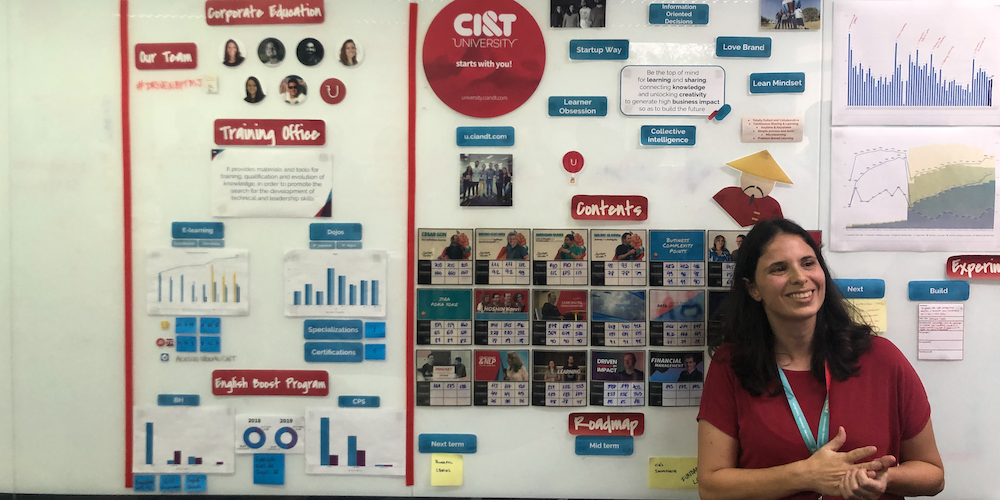
Analyzing the state and evolution of lean management in Russia
FEATURE ARTICLE - It is always fascinating to learn about the evolution of lean in other countries. This piece gives us the lowdown on the state of lean in Russia, a late adopter where interest is now growing fast in all sectors, from government to agriculture.
Words: Vyacheslav Boltrukevich, 'MBA-Production System' Program Director at Lomonosov Moscow State University Business School; Pavel Rabunets, Editor-in-Chief of www.leaninfo.ru and Development Manager of ICSS Publishing
At a recent Cabinet meeting, Alexey Ulyukayev, Minister of the Economic Development, said: "Russia is lagging behind. The levels of productivity in OECD countries are twice as a high as they are in Russia, while in the US they are 2.6 times higher."
Mr Ulyukayev is not the only one who worries about Russia's struggle to keep up. According to a 2009 study by McKinsey, the performance of Russian organizations was very low: in the five key sectors of the economy, Russia averaged a meagre 26% of the level of productivity of the United States. Even Prime Minister Dmitry Medvedev has made it a priority of the Government to increase the productivity of labour by 150% by 2018.
The economic sanctions imposed on Russia after the Crimea crisis have complicated things even further. We badly need to raise productivity and quality levels, which is why lean is more important than ever for us.
Despite the figures we just shared seem to suggest otherwive, lean-like production systems that are based on efficiency exist here too, as the experience of several Russian companies shows.

Two companies really stand out: Gorky Automobile Plant (GAZ) and Bratsk Aluminum Smelter (RUSAL Bratsk). The former implemented TPS principles in their classic form (on the assembly line) and is one of the most advanced lean organizations in Russia and beyond, while the latter is often considered as the first Russian company in which a production system has had a system-wide scope, covering everyone from operator to managing director. Actually, all RUSAL employees (not only those of the Bratsk smelter), or at least the vast majority of them, understand what the production system is and are involved in improvement activities. The company has achieved production levels of 250 tons per person per year, which corresponds to the output of leading global aluminum producers. At the same time, it has significantly improved working conditions and the quality of life of employees.
RUSAL's managing director, Sergey Filippov, published a book on the company's experience, the first title that described the adoption of lean principles in a Russian company. It became a bestseller, which indicates there is a lot of interest in this topic.
THE HISTORY OF LEAN IN RUSSIA
In Russia lean thinking has its roots in the development of industrial engineering that took place in the 1930s and in the successful experiments run by several state-owned military plants in the following 50 years to bring productivity and quality up to the level required (back in Soviet times, cost was not an issue).
The implementation of Lean/TPS principles as we know them began in the automotive and metallurgy industries in the early 2000s, after GAZ Group became a private enterprise. The company saw it as a no-brainer to follow Toyota's example on its assembly lines, in order to meet growing demand. At the same time, Russian metallurgical giants were entering the global market and were suddenly faced with strong competition. They had to find a way to reduce their costs and become more competitive.
There were a few other examples of companies that leaned out early, like Instrumrand (part of Ingersoll), which did so well that it became Mercedes Benz's only Russian supplier.
The populatization of lean ideas didn't start until 2002-2003. It's important to note that, as a rule, the early adopters were all very large, private businesses, which had no other choice but to change under the pressure of increasing global competition and had the resources to do so. However, since then the interest in lean has grown at a steady rate even among mid-size to large businesses, as indicated by the results of a survey of managers of industrial enterprises conducted by the Institute for Complex Strategic Studies between 2006 and 2012. It shows significant and steady increase in the number of Russian companies that are working on lean projects:

Graphic taken from Vera Kononova's (PhD, Institute for Complex Strategic Studies and Lomonosov Moscow State University Business School - kononova@icss.ac.ru) article, Gaining the Competitive Advantages through the Development of Production System; "The Future Competitiveness of EU and its Eastern Neighbors"
From a geographical perspective, it is not surprising to learn that lean organizations and plants are concentrated in the most heavily industrialized regions in the country – the Volga Federal District, Central Federal District, and Ural Federal District. More remote regions, like Siberia and the Far East, have only just appeared on the lean map of Russia.
TRENDS
LEAN "INFRASTRUCTURE" IN RUSSIA
One of the first books on lean in Russian was published by GAZ's shareholder Oleg Deripaska. It was Taiichi Ohno's Toyota Production System book, originally translated by Deripaska for internal use at GAZ in 2002.
Since then, things have changed and the lean literature has expanded. The number of books explaining basic lean concepts and the application of lean tools has increased substantially in the past decade. While initially early adopters of lean in the country only had access to books by Jim Womack, Taiichi Ohno and Jeffrey Liker (still the most popular), a variety of publications are now available. In our publishing house, ICSS (Institute for Complex Strategic Studies), we currently have 25 books on various aspects of lean manufacturing, for example.
As we know, the written word is not the only way to teach people about lean. As organizations' demand for lean capabilities increases, more and more universities are recognizing the importance of instilling the methodology in their students' minds (early experiments might soon be carried out in high schools as well). We are also noticing an increase in the number of scientific and graduate projects (final theses) dedicated to lean thinking and its many facets.

The number of lean programs taught in Russian universities is on the up, but they are mostly standalone courses within traditional management programs. At Lomonosov Moscow State University Business School, we have been running a unique educational program, an MBA in Production Systems, since 2005. Online courses are only just starting to appear, "Lean Thinking" being one of the few available.
The Internet is playing an increasingly big role in people's lives in Russia, so it will come as no surprise that in recent years the information provided online by pioneers of lean has grown in both quantity and quality: for example, our own Leaninfo.ru – launched in 2008 as the country's first blog on production management – has quickly grown into a very popular online source of information on lean for practitioners based all around Russia. The number of personal "lean blogs," mostly run by consultants, is also growing.
Speaking of consultants, it is interesting to see how more and more foreign consultancy firms are now actively entering the Russian market as a growing need for lean expertise is noticed and leveraged (when we didn't have a market to begin with, Russian companies scrambled to recruit Western or Japanese senseis).
Of course, we have a lot of lean events too. The most notable ones are the Lean Forum, taking place in November (this year it will be on the 10th), and the Lean Summit in the south of Russia, organized by our Business School and Kaizen Center (this year it was the third edition, with John Shook as one of the speakers).
There are also some regional activities, like the annual Lean without ties meeting, organized by Dmitry Stukalov (head of the Leanzone web forum), the Lean Club in Kaluga, and the Kaizen Club in Tomsk – just to name a few.
QUANTITATIVE AND QUALITATIVE CHANGES
Initially, companies understood lean manufacturing as a set of tools and selectively used its methods, such as 5s, SMED, VSM, kanban, to achieve local improvements. That, too, has changed, and it is great to see how managers are now realizing that lean is not just a toolbox, but an alternative management model that encompasses the whole enterprise. More and more organizations are now focusing their efforts and resources on the creation of the right relationship and on the development of people across all levels.
Experienced business leaders who have embraced lean are rethinking the speed at which they are developing their production systems. Until recently, many of them argued that a few months after a set of tools had been deployed on the shop floor and lean production introduced a fully lean enterprise would be born. Today, they understand what being on a lean journey really entails and recognize their organizations are just at the beginning of their transformation. More importantly, they now understand that the creation of an alternative production system and the implementation of lean manufacturing are associated with the development of people.
Lean in Russia may still be predominantly seen a manufacturing concept, but we would argue that the there is actually no sector of the economy that has not had any exposure to lean. The service industry is starting to show considerable interest in it, largely due to the work of Sberbank of Russia, the country's largest bank, which has been on a radical transformation of its processes since 2008 (the story of its journey was told in the book Elephant on the dance floor). To many service organizations, the experience of Sberbank has become proof of the fact that improvement is possible in any environment, even in one as complex as a bank.
In regions with a large concentration of lean enterprises, lean is spreading beyond manufacturing incredibly fast. For example, in the Kaluga region, where a powerful cluster of businesses operating in the automotive, aerospace and pharmaceuticals sectors operates, the local government has launched a lean initiative aimed at the provision of healthcare to citizens. Study missions for medical teams have been arranged in some of Europe's leading clinics.
There is also Tatarstan, of course, where lean has become a government-led regional development strategy: in several cities of the republic, projects on "lean municipalities" and "lean cities" have been launched. Khanty-Mansiysk even announced a "Lean Region" program! [Yalcin Ipbuken, President of Lean Institute Turkey, recently visited Tatarstan – here's what he saw.]
Lean construction principles have helped to build many of the buildings for the 2014 Sochi Olympics in a very short period of time, and even agriculture is making great strides in adopting lean. It is increasingly common to see agricultural organizations sharing their experience with lean with manufacturing companies that are starting out on their journeys. [Last year Planet Lean interviewed Anton Ulanov, CEO of Agroholding Kuban – check out the interview here.]
But we can't rest on our laurels just yet, as lean in still far from being a mass phenomenon in Russia.
CONCLUSION
The state of lean in our country was clearly outlined by Jim Womack during his visit in 2012. Here are his observations:
- Russia is a late adopter of lean thinking;
- Toyota was late to arrive to provide the example;
- There is a shortage of lean senseis;
- There is an expectation for low quality;
- Russia seems to be a hostile environment for lean in terms of government practices and local customs.

What advice did Jim give us, then? He suggested we learn the management principles and process methods we are currently lacking by running experiments in our organizations (the only real way to learn anything).
The trends we have identified in this article make us hopeful that the constraints to the dissemination of lean in Russia (lack of information, books, senseis, local expertise, and so on) and the misconceptions about its nature will be eliminated, and that more and more organizations in all sectors will embrace lean thinking.
In fact, we believe that the pace and reach of lean in Russia will grow substantially, because improvement has become a necessity: global competition is getting fiercer by the day, the economic sanctions are encouraging companies to find ways to work better and smarter, and the shortage of highly-skilled workers in the domestic market is putting people development in the spotlight. So the answer to the question "Will lean expand in Russia?" is very simple. It will. We have no other choice.
THE AUTHORS

Vyacheslav Boltrukevich, PhD is Assistant Professor of Operations Management and Director of the 'MBA-Production System' Program at Lomonosov Moscow State University Business School

Pavel Rabunets is the Editor in chief of Leaninfo.ru and the Development Manager and Publishing Editor at ICSS Publishing
Read more


FEATURE – In March 2019, this hospital partnered with the Lean Global Network on a two-day Jishuken event. Nearly two years later, the authors reflect on the legacy of that initiative.


RESEARCH - Offering us a glimpse into how the human mind works and into Toyota's approach to people engagement, this article tells us how to create a better working environment for our employees.


FEATURE – Last month, the Lean Global Network met in Brazil for its annual meeting. As part of it, we visited several amazing gembas. Three of our lean coaches reflect on what we learned.


FEATURE – The continuous flow of developing people’s capabilities throughout their studies and careers is lacking, to say the least. It’s time we saw this as one big value chain.

